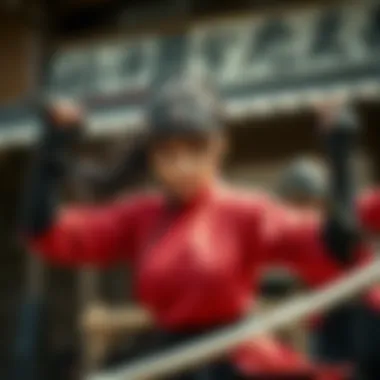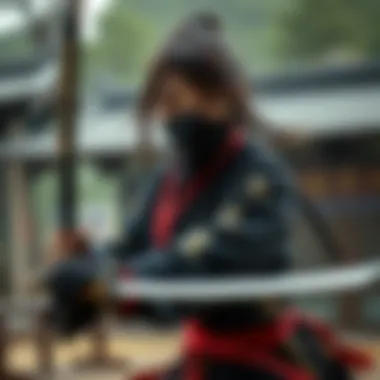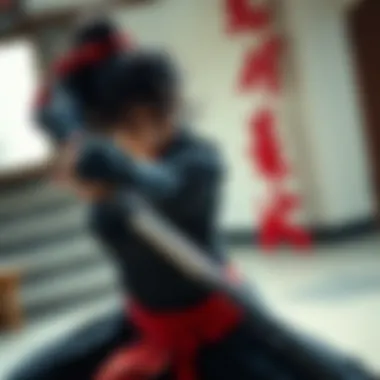Kunoichi Training: Exploring the Art of Ninja Women


Intro
The world of kunoichi, the female counterpart to the ninja, offers a glimpse into a historical tradition rich with depth and complexity. As we dive into kunoichi training, it becomes evident that this is not merely a series of physical exercises or combat techniques, but a comprehensive methodology that prepares these women for an array of challenges within the realms of stealth and espionage.
Understanding this training requires an appreciation for its historical context, methodologies, and ongoing relevance today. While it might be tempting to overlook the disciplined nature of such training, kunoichi have played pivotal roles across centuries in various cultural narratives, their lives often threading through stories of resilience and ingenuity.
The upcoming sections are structured meticulously to unfold this narrative. We will explore the essential training areas, including physical conditioning, combat techniques, and psychological preparation. Not only will this discussion provide insights into kunoichi training, but it will also underline the cultural significance of these formidable women throughout history and in contemporary society. By the end of the exploration, readers are expected to grasp both the intricate layers involved in the training and why it continues to hold relevance in today's world.
The Significance of Kunoichi Training
Kunoichi training isn't just about skill acquisition; it's about embodying the spirit of the ninja. These women were not just warriors; they were agents of espionage, skilled in gathering intelligence and executing vital missions with precision. Their training blends physical prowess with a deep understanding of psychology, allowing them to navigate both social and combat landscapes effectively. This duality is crucial for anyone looking to comprehend their significance beyond mere physical force.
Furthermore, recognizing the cultural backdrop of kunoichi enriches our understanding. These women often operated in male-dominated societies, where their survival and success depended on both subtlety and cunning. This historical perspective adds layers to the contemporary interpretations often seen in media, including popular anime and other forms of entertainment.
"The true strength of a kunoichi lies not just in her ability to fight, but in her mastery of stealth, strategy, and psychological insight."
As we progress, we will look into the various methodologies of training and their implications, both in the past and presently.
Stay tuned as we unravel the intricacies involved in becoming a kunoichi, understanding not just the what but the why behind each facet of their training.
Preface to Kunoichi
The term kunoichi refers to the female counterpart of the shinobi, or ninja, and their training taps into a rich tapestry of history, mythology, and culture. Understanding the significance of kunoichi is paramount, not just for appreciating the art of stealth but also for recognizing the pivotal role these women played in a largely male-dominated historical context. This section sets the stage for a comprehensive discussion surrounding the skills and philosophies that define these formidable women.
The importance of this topic lies in its multifaceted approach to ninja training. Kunoichi were not merely warriors; they embodied a unique blend of tactical intelligence, physical prowess, and psychological endurance. While historical records might focus on their male counterparts, the kunoichi's contributions in espionage and combat cannot be overlooked. By analyzing their extensive training regimens, we can gain insights into techniques that are relevant even today.
The following subsections will provide a foundational understanding of the kunoichi. We will explore the nuances of their definition and the historical context that gave rise to their unique roles in Japanese history. This examination forms a crucial lens through which to view the rest of the article, allowing readers to appreciate the depth and complexity behind what it means to be a kunoichi in both past and contemporary settings.
Definition and Historical Context
The term kunoichi has its roots in the intricate language of historical Japanese martial arts. The way it's derived hints at the sophisticated training these women underwent. Breakdown of the term shows that it is composed of the characters for "woman" and "three," a reflection of the three key skills associated with them: stealth, communication, and intelligence gathering. Historically, kunoichi were typically trained in the art of subterfuge and manipulation, fitting seamlessly into roles that allowed them to gather critical information in situations where men might draw too much attention.
Understanding the historical context of the kunoichi enriches our perception of their role in Japan's turbulent feudal past. While samurai clans fought for power, the kunoichi operated in shadows. They employed their skills to infiltrate enemy territories, often gaining access to crucial information. Their methods often included charm, guile, and espionage, elements that would later be depicted in literature and popular culture.
Role of Kunoichi in Japanese History
Looking deeper into history, kunoichi played essential yet often overlooked roles in espionage and warfare. These women utilized their looks and social standings to infiltrate places men could not. In many cases, their involvement shifted the tide of battle or political intrigue. For instance, during the Sengoku period, the presence of a kunoichi in the court of an enemy might lead to a decisive shift; their ability to gather and relay information often proved invaluable for their own clans.
"The kunoichi blended the art of intelligence with the subtleties of feminine wiles; they were the unseen forces behind some of Japan's most critical historical events."
Throughout centuries, the ability to navigate societal norms made these women integral to strategies of war and peace alike. Documented accounts hint at several notable kunoichi, whose stories continue to captivate the imagination of many today. Their legacy not only informs us of their historical importance but also prompts contemporary discussions regarding gender roles in martial arts and self-defense today. Through their training, kunoichi cultivated physical and mental skills that resonated outside their immediate historical context and continue to inspire modern practices.
Foundational Principles of Kunoichi Training
The training of kunoichi, or female ninjas, is deeply rooted in principles that extend beyond mere physical prowess. The foundational elements of their training create a framework for developing skills that are essential for stealth, agility, and combat effectiveness. Understanding these principles is vital not only for appreciating the art itself but also for recognizing the perseverance and discipline that exemplify the spirit of these women.
The Philosophy Behind Ninja Training
At its core, the philosophy of kunoichi training emphasizes the intertwining of mind and body. Unlike traditional martial arts that often focus on overt strength, ninjas cultivate a balance between mental acuity and physical agility. The often-quoted mantra, "silent as a shadow, quick as a whip," encapsulates this philosophy. In essence, every action is intentional, grounded in a deep understanding of one's environment and the psychological state of both themselves and their opponents.
Training often incorporates disciplines such as meditation and focus drills that promote mental clarity. This mental conditioning aids kunoichi during high-pressure situations, allowing them to perform with precision and poise. Such an approach not only highlights their dedication to mastering the art of stealth but also underscores the importance of strategic thinking in their training.
"To master oneself is the first task of the kunoichi. The body follows, only if the mind leads."
Importance of Stealth and Mobility
Stealth and mobility form the backbone of kunoichi training. These women were not just fighters; they were strategists who understood the terrain, the shadows, and the best moments to strike. Their training was stage-managed to harness qualities such as silence, swiftness, and the ability to adapt quickly to changing circumstances.
The importance of stealth cannot be overstated in the context of espionage and infiltration. Training regimens often included specific exercises to improve movement in various environments, whether urban landscapes or dense forests. Learning how to traverse these settings without drawing attention was a crucial skill for a kunoichi.
Key Techniques in Stealth and Mobility:


- Low-Impact Footwork: Training to minimize noise during movement.
- Cloaking Skills: Using the environment to hide in plain sight.
- Silent Breathing: Techniques to control breath, allowing for silent navigation.
Understanding mobility extends beyond just physical movement; it is also about mental agility. Kunoichi had to assess situations and make decisions on the fly, adapting strategies as needed. This highlights how foundational principles of training interrelate, showcasing that every aspect is crucial for honing their skills as stealth operatives.
At the heart of kunoichi practices lies the commitment to absolute discretion, allowing them to fulfill their missions while evading capture or confrontation. In a world where every whisper can echo into the vastness of history, these principles ensured that the legacy of the kunoichi would remain shrouded in intrigue.
Physical Conditioning in Kunoichi Training
Physical conditioning serves as the backbone of a kunoichi's training journey, preparing them not only for the demands of combat but also for the intricacies of stealth missions. Developing a strong body influences a range of skills, including agility, speed, and endurance. When one thinks of ninja women, it's easy to overlook the sheer physicality required for a role steeped in deception and agility. Conditioning sharpens the edge they possess, allowing them to adapt to various scenarios while maintaining grace and efficiency.
The regimen of a kunoichi's training focuses on three main components: endurance, strength, and flexibility. Each facet builds on the others, creating a robust foundation for the skills they need to master. Below is a closer look at each element that contributes to overall physical readiness.
Endurance Training Regimens
Endurance training is crucial for any kunoichi. High levels of stamina allow them to execute strategies over extended periods without succumbing to fatigue. This doesn’t just mean running endless miles; it's about increasing the efficiency of the body’s oxygen use.
Training might include:
- Long-distance running: Builds cardiovascular strength and prepares the body for prolonged physical exertion.
- High-intensity interval training (HIIT): Mimics the action-packed nature of ninja missions, enhancing both aerobic and anaerobic capacities in shorter bursts.
- Circuit training: A combination of strength, agility, and aerobic movements to keep them in top shape.
In the words of a seasoned kunoichi, "It’s not just about running; it’s about finding your limits and pushing them back."
Strength Training Techniques
Strength is an essential aspect of physical conditioning, allowing kunoichi to defend themselves and engage effectively in hand-to-hand combat. Strong muscles contribute to powerful strikes and effective grappling maneuvers. The following techniques often weave into their strength training routines:
- Body-weight exercises: Push-ups, pull-ups, and squats help develop functional strength without the need for equipment, perfect for stealthy training environments.
- Weighted resistance training: Incorporating weights can help in building muscle mass and improving overall power for combat situations.
- Core workouts: A strong core is vital for balance and stability, especially when executing advanced maneuvers or overcoming obstacles.
Flexibility and Agility Drills
Flexibility and agility are not merely supplementary but rather fundamental qualities in the life of a kunoichi. Being nimble allows quick maneuvering and stealthy movements, which are vital when dodging or slipping past adversaries. Training often includes:
- Dynamic stretching: Important for warming up muscles and enhancing overall range of motion.
- Yoga or martial arts forms: These practices increase flexibility and promote mental calmness as well, helping them center their focus.
- Agility ladders and cones: Drills designed to improve foot speed, coordination, and body control ensure that they can navigate various terrains effortlessly.
A remarkable aspect of kounichi training is that every physical element is honed with a purpose, ensuring that the individual emerges not just stronger or faster, but as a well-rounded performer, capable of adjusting to the challenges that each unique mission presents.
Combat Skills Development
The realm of Kunoichi training is incomplete without a profound emphasis on Combat Skills Development. This aspect not only hones physical abilities, but it also enhances mental acuity, allowing the kunoichi to navigate the complexities of their roles with poise and precision. The art of combat extends beyond merely grappling or weapon handling; it encapsulates the mental fortitude required to confront danger head-on, an essential trait for one navigating the shadows. Moreover, understanding and mastering diverse combat skills provides several benefits, such as boosting confidence and fostering adaptability in unpredictable situations.
Unarmed Self-Defense Techniques
A fundamental aspect of the Kunoichi's repertoire is the mastery of unarmed self-defense techniques. These techniques empower women to protect themselves without relying on weapons. Techniques like Aikido and Krav Maga often come into play, with movements designed to counter an attacker’s strength using their momentum against them. For instance, a well-timed throw can turn the tables in dire circumstances.
Training in unarmed combat makes practitioners alert and agile. The focus on body awareness and spatial orientation enhances reflexive responses when faced with danger. Additionally, the mental discipline required during these training sessions offers a dual benefit—sharpening the mind while strengthening the body. The ability to remain calm under pressure and to think creatively during a confrontation often distinguishes a successful kunoichi from the rest.
Weapon Mastery
Weapon mastery represents the zenith of combat skills development within Kunoichi training. It provides a kunoichi with flexible options when it comes to self-defense and offense, adapting their approach to suit different situations. The selection of weapons is not arbitrary; each has unique characteristics and requires specific strategies for effective use.
Traditional Weapons
Traditional weapons such as the katana, shuriken, and tonfa hold a rich historical significance in Kunoichi training. The katana, revered for its artistry and effectiveness, demands extensive training to wield effectively. Its design allows for swift attacks, while a deep understanding of its handling can illuminate aspects of Japanese culture.
A key characteristic of traditional weapons lies in their symbolism and heritage. They are not merely tools; they represent a lineage of skill passed down through generations. Learning to handle these weapons cultivates respect and appreciation for the craft involved. However, one must consider the challenge of carrying such weapons discreetly in modern-day settings.
"The control and grace involved in wielding a katana are akin to a dance; the body moves fluidly, guided by years of training."
Modern Adaptations
Modern adaptations of weaponry focus on practicality and accessibility in contemporary environments. Tools like tactical pens and self-defense keychains are becoming increasingly popular, offering compact options for self-defense. These methods spring from the necessity of adapting to urban life, where carrying traditional weapons may not be feasible.
The hallmark of modern adaptations is their ease of use and concealment. Practitioners can integrate them effortlessly into their daily lives. While they may not have the historical clout of traditional weapons, they fill an essential gap in contemporary self-defense strategies, catering to a wider audience.


However, reliance on modern alternatives raises questions about depth of training. Their accessibility might lead to less rigorous practice compared to extensive traditional weapon training. The kunoichi must weigh the benefits of convenience against the discipline acquired through classical techniques.
Psychological Preparation
Psychological preparation forms the backbone of effective kunoichi training. While physical strength and combat skills are important, the mind serves as the true weapon for these ninja women. This preparation involves cultivating states of mental resilience and adaptable thinking. To navigate the dangerous and unpredictable world they often inhabit, kunoichi must develop strategies that blend focus, intuition, and quick decision-making abilities.
Mental Resilience and Focus
One of the most crucial aspects of psychological preparation is building mental resilience. Kunoichi need to withstand not just physical challenges but also the psychological ones that come with their roles. This involves training the mind to remain calm and collected, even in the most stressful situations. During missions, a kunoichi must keep her wits about her; a single moment of panic can lead to dire consequences.
Benefits include:
- Enhanced decision-making abilities under pressure.
- Improved concentration, which is vital for stealth.
- The capacity to recover quickly from setbacks, both physical and emotional.
To develop these aspects, many kunoichi engage in practices like meditation and visualization. The act of envisioning successful mission outcomes helps solidify their mental preparation. When they visualize their movements and the execution of tasks, it becomes easier to replicate those actions in life.
Survival Mindset and Adaptability
The survival mindset is another pillar of psychological readiness. A kunoichi must embrace the ability to adapt to her environment and unexpected changes. The essence of survival often hinges on one's ability to think on their feet, making quick adjustments based on evolving situations. This adaptability often turns potentially hazardous encounters into manageable ones.
"Flexibility is the key to air power."
Similarly, nurturing a survival mindset means preparing for worst-case scenarios. Kunoichi often train with a focus on problem-solving skills, analyzing various situations they might face and determining the best responses.
Key considerations include:
- Training in diverse environments to simulate real-world challenges.
- Developing intuition to gauge situations quickly and accurately.
- An openness to learning from experiences, turning mistakes into knowledge for future encounters.
Through rigorous training and psychological conditioning, the kunoichi fosters a strong mental pulse that keeps her grounded in adversity. This focus not only empowers them in their dangerous line of work, but also influences their self-image and societal perceptions.
In our current age, as more women step into roles that require significant courage and intelligence, understanding psychological preparation allows for broader discussions on female empowerment and strength within various communities. As such, the legacy of kunoichi transcends mere historical contexts, influencing contemporary feminist movements toward female empowerment in action and thought.
For further explorations on the role of mental resilience in various fields, you can refer to resources at britannica.com or wikipedia.org for in-depth studies and case analyses.
Strategic Thinking and Espionage Skills
In the intricate tapestry of kunoichi training, strategic thinking and espionage skills are the threads that bind the physical and mental rigors of their craft. Unlike mere combat techniques, these skills underscore the intellectual acumen that a kunoichi must have. They require a deft balance between analytical ability and tactical execution, making them indispensable for successful maneuvers in the shadows.
Strategic thinking enables these ninja women to assess situations accurately and devise plans that maximize their chances of success while minimizing risks. This critical cognitive skill is vital for navigating the complexities of espionage, where a well-thought-out approach can mean the difference between a successful mission and potential failure or exposure.
The benefits of honing these skills are multifold:
- Improved Situational Awareness
Kunoichi must remain alert to their surroundings. With a heightened sense of observation, they can interpret subtle cues, such as body language or environmental changes, that may indicate danger or opportunity. - Adaptability Under Pressure
In the heat of the moment, a kunoichi with strong strategic thinking can pivot plans quickly, adjusting to unforeseen developments. Adaptability allows them to seize unexpected advantages that may arise during operations. - Collaboration and Communication
Understanding the broader objectives facilitates the ability to work effectively with allies. Kunoichi must communicate their insights succinctly, ensuring that teams are aligned in their efforts.
With these skills, a kunoichi transforms from a mere fighter into a calculated strategist, capable of influencing outcomes from behind the scenes.
Observation and Analysis Techniques
Observation is the bedrock of effective espionage, forming the basis for collecting invaluable intelligence. Kunoichi are trained to notice details that others may overlook; this skill is not merely about sight but also incorporating other senses to gather context.
- Mindful Awareness
This involves an acute sense of focus, training the mind to take in surroundings without becoming overwhelmed. Practicing mindfulness can increase this skill over time, allowing the kunoichi to remain extremely aware without drawing attention to herself. - Information Gathering
Kunoichi employ systematic methods for data collection, including monitoring conversations, body language, and even environmental factors such as weather alterations or the comings and goings of people in a specific location. - Analyzing Patterns
Once information is collected, the real work begins. Analyzing behaviors and patterns allows the kunoichi to predict actions, which is essential for making strategic decisions ahead of time. This kind of analysis can include understanding opponents' habits, which could lead to identifying weaknesses during a mission.
Planning and Execution of Missions
The crux of any successful intelligence operation lies in meticulous planning and execution. This phase involves thorough preparations and crafting tactics to ensure the mission achieves its intended goals without detection.
- Mission Objectives
Clearly defining the mission's purpose helps to streamline efforts. A kunoichi must assess what the priority is—whether it’s gathering information, sabotage, or rescue—before devising a complete operational strategy. - Route Planning
Knowing the landscape is crucial. Utilizing maps and reconnaissance, kunoichi often plan multiple escape routes, ensuring they are well-prepared for various contingencies. - Implementation Tactics
Upon execution, timing can be everything. Kunoichi are trained to maintain composure and follow through with precision as they enact their plan. Adjustments may need to be made in real-time, so preparation and adaptability come hand-in-hand.
"A good plan executed now is better than a perfect plan executed next week."
As kunoichi refine their strategic thinking and espionage abilities through rigorous practice, they gain not only efficiency in missions but also bolster their overall confidence—essential traits for any woman stepping into the demanding world of ninjutsu.
For further reading, explore sources like Wikipedia, Britannica, and Reddit. There are invaluable discussions and resources available to deepen your understanding of this fascinating art.


Cultural Significance of Kunoichi
The cultural significance of kunoichi extends beyond their historical roles as female ninja, intertwining with themes of femininity, strength, and resilience. Kunoichi symbolize a unique blend of tradition and empowerment that resonates in modern contexts. Through their portrayal in various forms of media and their emerging role in contemporary discussions on gender equality, they have become icons of women's capabilities, stealth, and intellect. These elements create a platform for analyzing how the image of kunoichi can inspire new generations and reshape societal views on women's roles.
Representation in Popular Culture
In popular culture, kunoichi have found their way into various storytelling mediums such as anime, manga, and films. The portrayal of these female ninjas often oscillates between romanticized versions of deadly seductresses and strong, independent warriors. For example, characters like Tsunade from Naruto illustrate the strength and determination of kunoichi, challenging traditional stereotypes of women as merely passive or subordinate. This duality reflects a broader societal narrative where women are not just participants but leaders and heroes in their own right.
Moreover, these representations often introduce significant themes related to empowerment. The complex narratives surrounding kunoichi in properties like Ninja Scroll and Hellsing highlight their skills, intelligence, and strategic thinking, cultivating a sense of admiration among audiences. Some fans appreciate how these characters not only possess physical prowess but also navigate intricate emotional and psychological terrains, making them multifaceted and relatable.
"In a world that thrives on complexity, the image of the kunoichi perfectly embodies the resilience and the depth of women's experiences."
Thus, the cultural representation of kunoichi is essential for understanding their significance in contemporary narratives. They serve not only as symbols of fight and survival against oppression but also as reflections of evolving gender roles.
Impact on Modern Feminism
The influence of kunoichi training on modern feminism cannot be overlooked. By embodying traits typically associated with empowerment - like independence, resourcefulness, and resilience - they provide a framework for discussions on women's rights and agency. Kunoichi challenge traditional norms, showcasing diverse portrayals that merge both feminine qualities and combat prowess, often resulting in a conversation about the roles women can occupy in society today.
Feminist discourse has increasingly embraced the representation of strong female figures as essential to mainstream cultural narratives. This is evident in how female ninjas are received by audiences who feel empowered by their stories. More than just fantasy figures, kunoichi open avenues for self-empowerment and advocacy in real life. Their journeys often resonate with women striving for more autonomy in various spheres, from professional environments to personal relationships.
Modern-Day Implications of Kunoichi Training
The relevance of kunoichi training extends far beyond its historical context; it resonates deeply within modern society. The transformation of traditional techniques to contemporary practices reflects a conscious effort to adapt ancient wisdom to current needs. In an age where self-defense and personal empowerment are hot topics, the foundation laid by kunoichi offers valuable insights.
Today, the principles of stealth, agility, and strategic thinking from kunoichi methods are highly applicable across various domains such as self-defense, martial arts, and even corporate strategies. This adaptation underscores the timeless nature of these teachings and their ability to empower individuals, especially women. The skills cultivated through this training not only serve physical defensive purposes but also enhance overall confidence and assertiveness.
"Self-defense is not merely a physical act; it is a mindset rooted in awareness and preparedness."
Training Programs and Workshops
In recent years, there has been a notable rise in programs and workshops aimed at disseminating kunoichi training. These modern iterations of training harness the essence of historical methods while providing an accessible platform for individuals to learn.
Classes often incorporate techniques like:
- Situational awareness: Teaching students to remain alert and aware of their surroundings, akin to how kunoichi would have been in hostile situations.
- Movement drills: Curriculums include agility and flexibility exercises that enhance mobility and make physical response effective during self-defense scenarios.
- Mental conditioning: Emphasizing the psychological components that underpin many physical techniques, helping participants develop a resilient mindset.
Such workshops do not only attract martial arts enthusiasts or those seeking self-defense skills; they engage a broad demographic interested in personal development. Many programs also aim to cultivate a community spirit, emphasizing shared experiences and support systems among participants.
Influence on Self-Defense Movements
Kunoichi training's impact on modern self-defense movements is both profound and encouraging. By integrating historical knowledge with contemporary self-defense principles, these methods significantly elevate the discourse around empowerment.
The philosophy behind kunoichi emphasizes:
- Empowerment through education: Women participating in self-defense classes based on kunoichi techniques often experience an increase in self-esteem and confidence, vital in navigating various life challenges.
- Diverse techniques: Self-defense practices influenced by kunoichi encompass a range of techniques that can be easily implemented in real-life situations. Programs fuse traditional armed and unarmed combat techniques with modern self-defense strategies, enhancing their practicality.
The reality is that self-defense is not just about physical confrontation; it's also about prevention and strategic thinking. The kunoichi's legacy underscores an important narrative: that knowledge and preparation can often deter conflict before it arises.
As society continues to evolve, the teachings of kunoichi can serve as a bedrock for innovative self-defense strategies, promoting resilience and awareness in an uncertain world.
Finale: The Legacy of Kunoichi
The legacy of the kunoichi, or female ninja, is a tapestry woven with threads of resilience, cleverness, and an indomitable spirit. From their historical roots in feudal Japan to their modern interpretations, these women have left an indelible mark on both ninja traditions and contemporary society. This section wraps up the core themes discussed in the article, emphasizing the cultural and practical significance of kunoichi training today.
Endurance of Tradition in Modern Society
As the world races through technological advancements and rapid changes in gender roles, the traditions embodied by kunoichi persist remarkably. Their methods, often overlooked in mainstream historical narratives, continue to captivate enthusiasts in martial arts and espionage alike. A few key aspects that highlight the endurance of these traditions include:
- Training Methodologies: The principles behind physical conditioning, stealth tactics, and psychological resilience taught to kunoichi are relevant to today’s self-defense discussions. Modern training programs still incorporate these traditional methods but often modify them to suit contemporary lifestyles.
- Cultural Practices: Various martial arts schools incorporate kunoichi techniques, ensuring that these practices are not lost. There are workshops and seminars led by experts who wish to educate the young on these noble arts, fostering a respectful appreciation for the past while adapting to present needs.
- Representation in Media: The portrayal of kunoichi in anime, movies, and literature has also helped to maintain their legacy. Characters inspired by these historical women showcase a blend of femininity and strength, helping to redefine what it means to be both a woman and a warrior. For example, Naruto features strong female characters who embody both the spirit and skills of the kunoichi.
"The legacy of the kunoichi isn't just about historical texts; it's alive and well in our contemporary culture, proved by the ongoing interest and respect targeted towards these skilled women."
Future Trends in Kunoichi Training
Looking forward, the future trends in kunoichi training are poised to blend tradition with innovation. As society evolves, so too does the need for comprehensive training that reflects not only physical capability but also adaptability in an ever-changing world. Some emergent trends include:
- Technology Integration: The use of technology in teaching these skills is on the rise. Virtual reality training tools can simulate scenarios that a kunoichi might face, allowing students to hone their abilities in a controlled environment.
- Focus on Inclusivity: There’s a growing recognition of the importance of diverse voices in martial arts. Modern kunoichi training programs now emphasize inclusivity, welcoming participants from all backgrounds and genders, which can fundamentally change how these ancient skills are taught and perceived.
- Holistic Training Approaches: Future programs might delve deeper into mind-body connections, combining physical training with mindfulness and mental conditioning strategies, acknowledging that a strong mind is as crucial as a strong body.
- Sustainability Emphasis: There’s an increasing awareness of sustainability in all areas of life. This could shape kunoichi training to incorporate practices that respect the environment while teaching effective skills.
In summary, the legacy of kunoichi is not a closed chapter of history but a vibrant narrative that continues to evolve. The skills, philosophies, and cultural significance they represent are more pertinent today than ever, inviting both admiration and deeper exploration into their methods and traditions. Through education and innovation, we can ensure that the spirit of the kunoichi thrives and inspires future generations.















